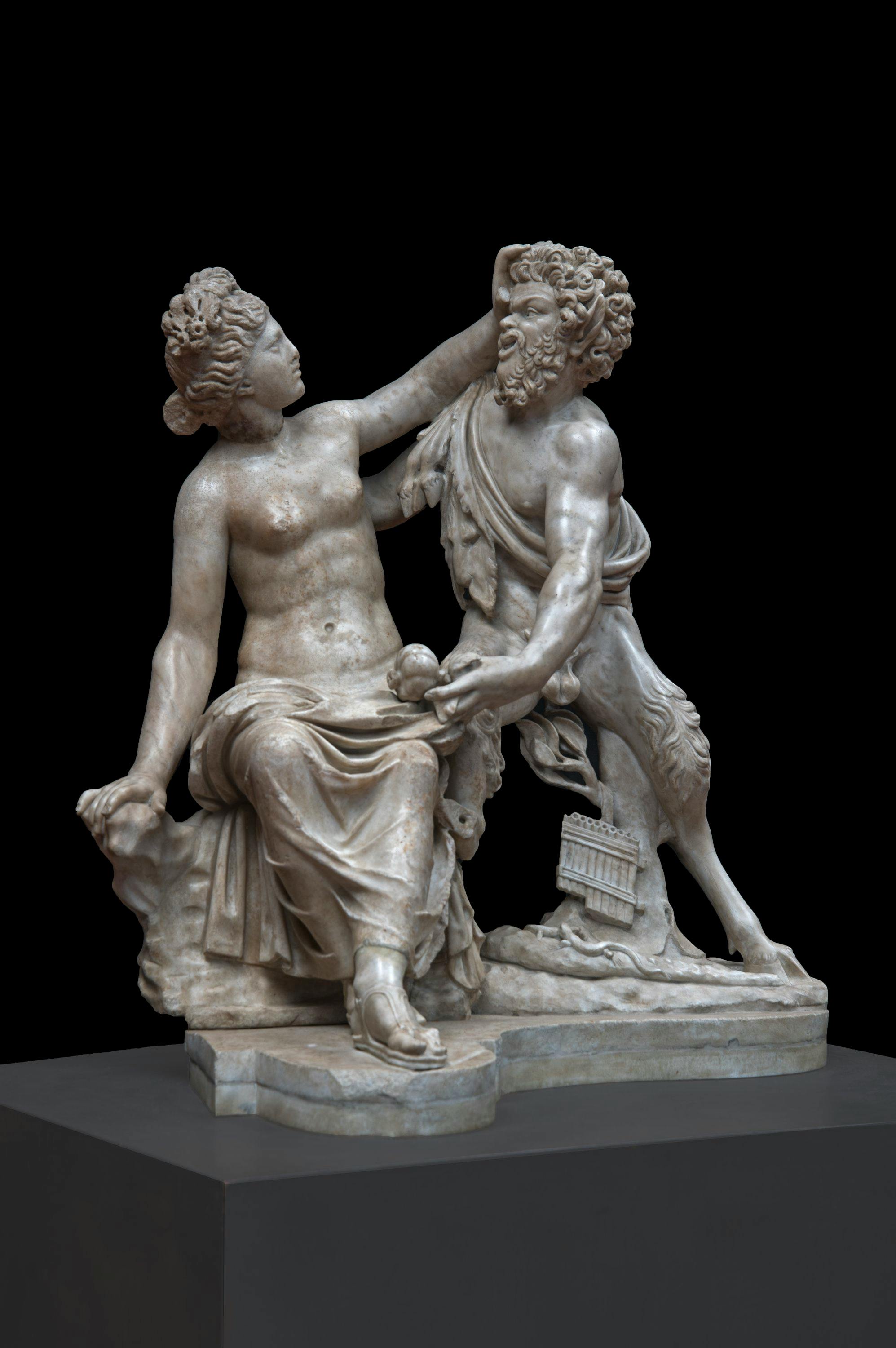Group of Pan and Hermaphroditus
Roman Art
The sculptural group consisting of the satyr Pan and Hermaphroditus pertained to the collection of Cardinal Leopold de' Medici (1617 - 1675).
The current appearance of the group is the product of extensive modern-day restoration. As a matter of fact, the only original parts are the torso of Hermaphroditus, the drapery covering his legs, and part of the rock on which he is sitting; the satyr, on the other hand, has been almost entirely reconstructed. With regard to the latter, an exquisitely baroque taste can be appreciated in the workmanship of the head, particularly in the hair pierced by the drill into large, chiaroscuro locks and in the anti-naturalistic face characterised by a malignant toothless grin. However, it must be noted that Pan's current pose should not differ much from the original: thanks to a few but crucial ancient remains, such as the hand and a portion of the forearm that are pulled behind Hermaphroditus' back, as well as the lower part of the right paw, it has been possible to hypothesise a plausible reconstruction of the original piece. The sculpture should have depicted Hermaphroditus in the act of turning his head sharply and raising his left hand - with a missing thumb, now lost - in an attempt to ward off the intrusive admirer.
The iconography of Hermaphroditus seems to be the reworking of a statuary type from the mid 2nd century B.C., which depicted a female figure seated on a rock and was characterised by a twisting of the torso and by the crossed legs. In the Imperial age, it was often used for the depiction of nymphs whose upper body was uncovered. The Gallery houses another statue of this type, the Nereid on a sea horse (inv. Sculptures 1914 no. 208), which in turn is related to a Seated Nymph from the National Roman Museum. Having made this consideration and analysed the use of the drill and chiaroscuro, this work should probably be dated back to the Antonine period (138 - 161 A.D.), although the rendering of the folds of the drapery would suggest the Hadrianic period (117 - 138 AD). In any case, the hypothesis that it pertains to the imperial period is confirmed by the presence of erotic motifs on Pan's flute and the lizard fight, which can be admired on the club near the trunk that serves as a support for the god of the woods. Even though this is a decorative element from the late Hellenistic period (2nd-1st century B.C.), it was widely used in the Roman world of the imperial age in both public and private spaces.
Again with regard to the restorations, the base supporting the two figures is modern, while there are traces of post-antique reworking on the end of the satyr's right leg and on the penis of Hermaphroditus. Similarly, the head of Hermaphroditus - which echoes the models of the head of Aphrodite in the Praxitelean tradition (in particular, the large bow that collects the hair at the top of the head suggests an association with the head of the type Capitoline Aphrodite; Katalog der antiken Bildwerke 2011, 430 - 432, no. 85) - is ancient but not original. This can be verified by analysing the different types of marble used and by the fact that the ancient surface is very worn, particularly on the face of Hermaphroditus.
This sculpture, of great workmanship, bears similarities with the homonymous group depicting the same subject that is preserved in the Vatican: both sculptures are in fact a pastiche, i.e. the result of a mix of different statuary types and models. The sculpture only entered the Gallery in 1771, after being moved from the Wardrobe of the Pitti Palace.
3D model realised in collaboration with Indiana University, Politecnico di Milano and University of Florence
http://www.digitalsculpture.org/florence/main/model/7291bcf3069b4b8489711ba629008484
G.Capecchi, La collezione di antichità del Cardinale Leopoldo dei Medici. I marmi, p. 131, in “Atti e memorie dell’accademia toscana di scienze e lettere La Colombaria”, XLIV, n. s. XXX, pp. 125 – 145, 1979; A. Cecchi, C. Gasparri, La Villa Médicis. Volume 4. Le collezioni del Cardinale Ferdinando. I dipinti e le sculture, p. 292, n. 516, Roma, 2009; M. Cadario, L’immagine di Ermafrodito tra letteratura ed iconografia, p. 237, in Il gran poema delle passioni e delle meraviglie. Ovidio e il repertorio letterario e figurativo tra antico e passione per l’antico, atti del convegno (Padova, 15 – 17 settembre 2011), pp. 235 - 246, 2012b; A. Muscillo, Catalogo I. Leopoldo de’ Medici, n. 33, pp. 296 – 297 in V. Conticelli, R. Gennaioli, M. Sframeli (a cura di), Leopoldo de’ Medici. Principe dei collezionisti, catalogo della mostra, Sillabe, Livorno, 2017
